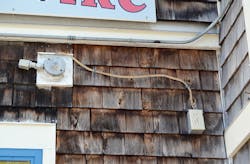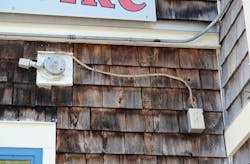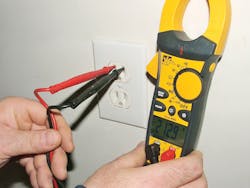How well do you know the Code? Think you can spot violations the original installer either ignored or couldn’t identify? Here’s your chance to moonlight as an electrical inspector and second-guess someone else’s work from the safety of your living room or office. Can you identify the specific Code violation(s) in this photo? Note: Submitted comments must include specific references from the 2017 NEC.
Hint: Wet location woes
October Winners
I received a lot of reader responses on this photo, but I could only choose three winners. They are: John E. Skog, a licensed professional engineer with Maintenance and Test Engineering LLC of Olympia, Wash.; Keith Cagigas, an electrical occupations instructor with Columbia Montour Area Vo-Tech in Bloomsburg, Pa.; and Paul F. McDonald, an electrician from Holyoke, Mass.
Based on the voltage shown on the meter, this 125V-rated receptacle is clearly in violation of Sec. 110.4, which does not permit equipment to be installed on circuits where the nominal voltage is higher than the equipment rating. Using this receptacle at this voltage would also violate Sec. 110.3(B), since it is not designed or listed for this voltage level. Similarly, Sec. 406.4(A) requires this receptacle to be installed on a circuit of the voltage class and current for which it’s rated.
One reader pointed out that this may have been a result of the installer inadvertently using the high-leg of a mid-point grounded delta system along with the grounded conductor to supply this receptacle outlet. While that could happen, in this particular case, the installer mistakenly connected a 12/2 NM cable to a 2-pole, 20A circuit breaker to supply power to this receptacle.
About the Author

Russ LeBlanc
Owner
Russ started in the electrical trade as an apprentice in 1985. He worked his way up to become a Journeyman Electrician and then eventually became a Master Electrician and Licensed Construction Supervisor. In 1999 Russ become an Electrical Instructor for The Peterson School of Engineering in Massachusetts where he developed his passion for teaching, and quickly became Department Head of Electrical Instruction. Russ has taught thousands of apprentices, electricians, engineers, inspectors, and other electrical professionals during his career as an instructor. He continues to provide electrical professionals with Electrical Code seminars, Arc-Flash Awareness training seminars and educational material through his LeBlanc Consulting Services in North Reading, MA whose specialty is educating electricians. He has been an active member of the NFPA Electrical Section and has authored hundreds of National Electrical Code proposals and comments which have become Code rules to improve the safety for the electrical industry. Russ is also an IAEI certified Electrical Inspector.
Please visit www.russleblanc.net for more information.


